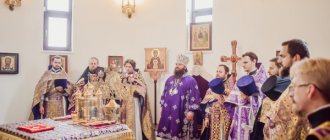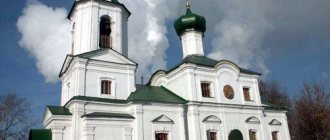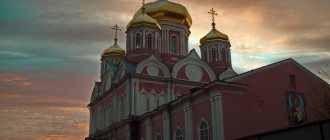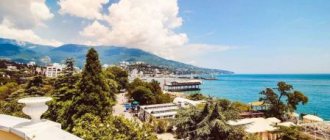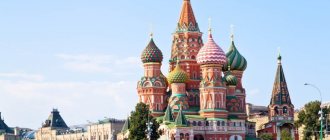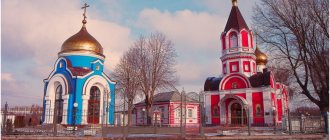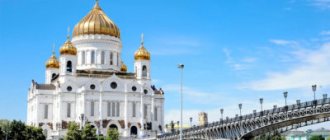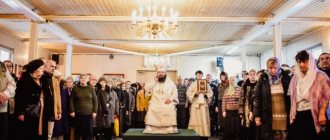How to get there by public transport
You need to take the metro to the Volokamskaya station. Passing the underground passage, exit onto Novotushinsky Proezd. Turn right, after 300 meters you will see the cathedral building.
From the Tushinskaya station there is public transport, namely buses No. 904, 266, 2. You should get off at the First Microdistrict in Mitino.
You can get to the church from the Sokol and Belorusskaya metro stations by bus No. 904. Stop at the station “First Microdistrict in Mitino”. The cathedral is located near the bus stop.
Temple clergy, address
Priest George Geronimus was appointed rector of the Church of the All-Merciful Savior. He is married and has six sons.
Finding a temple in Mitino is not so difficult:
- official address: 125464, North-Western district, Moscow, Pyatnitskoe highway, building 5, phone: +7 (916) 251-7590;
- metro station: Pyatnitskoe highway, Volokolamskaya, cross Novotushinsky passage along the underground passage, then walk to the right 300 meters along multi-storey residential buildings;
- from the Tushinskaya metro station by buses 2, 266, 904. Stop: the first microdistrict of Mitino. The temple is located opposite the bus stop;
- from the metro station "Belorusskaya", "Sokol" - by bus 904.
History of the temple
On the site of the cathedral in the 13th century there were the Spassky Kurgans. Tsarevich False Dmitry hid his numerous riches under one of them. In the 14th century, instead of the settlement of Spas, the Transfiguration Church was built, which was soon destroyed. In the second half of the 17th century, a parish church was founded in Spassky Selo.
And by the end of the 19th century, the old Transfiguration Cathedral ceased to exist. A monastery was built on the shore. As a result of its erosion, cracks formed in the temple, so in 1890 the church had to be demolished. Instead, a wooden chapel was built.
In 1926, Spas had about 900 residents, whose standard of living was not particularly luxurious. After 3 years, a collective farm was created in the village, which was called “Testaments of Ilyich.”
The cathedral closed in 1935, and priest Alexander and his father were shot. Until 2012, no activity was carried out on the site of the church building. Today, the Spasskaya Church has been built here, which is visited daily by the Orthodox people.
The history of the creation of the Church of the All-Merciful Savior
The history of the creation of the Orthodox church is very interesting and extraordinary. This majestic temple was built thanks to the Moscow “Program 200”. This program provided for the construction of Christian churches in the capital itself and in its environs. Already in September 2011, open-air services began to be held regularly at the construction site of the future temple. Moreover, they were carried out in any weather. The Orthodox community of the future church formed quite quickly and became very numerous.
The first stone of the future temple was laid in 2012 by Patriarch Kirill. The lighting of the first foundation stone took place on March 6, 2012. In the same year, construction of the Orthodox shrine began.
On the eve of the Nativity of Christ at the beginning of 2012, on the site of the future majestic temple, with the blessing of His Holiness Patriarch Kirill, the Svyatopokrovsky wooden church was erected. Already on the Christmas holiday, the first Divine service was held there. Liturgies were celebrated in a wooden temporary church several times a week. The last service was celebrated on the Feast of the Intercession of the Mother of God on October 14.
Already at the end of the summer of 2014, this temporary temple was moved to another place where the construction of a new temple on Fabricius Street was also planned.
Exactly a year later, gilded crosses and majestic domes already towered over the temple. In August 2013, the construction work of the new temple was almost completed. On August 14, the Divine Liturgy was served in the new church.
In addition to the temple, a clergy house and a bell tower were erected on its territory. There is a regular Sunday school at the church, where small and young students learn the basics of Orthodoxy, learn holy letters, etc.
With the blessing of His Holiness Patriarch Kirill, at the beginning of the summer of 2014, an additional altar was built in the new church (in honor of Righteous Lazarus). Early liturgies take place on this altar.
A characteristic feature of an Orthodox church is the presence in it of special devices for the infirm and elderly.
The central room of the temple can accommodate up to 550 parishioners at a time. But despite such a large capacity, quite often many more people come.
Already at the beginning of 2021, the land plot under the territory of the temple, the temple itself, and the parable house were registered as the property of the Patriarchal Compound.
Architect and exterior decoration of the temple
On March 6, 2012 (before the start of construction of the church), a ceremony was held to consecrate the building material from which the cathedral was built. It opened in 2013 (August), and the first service was held the next day.
The Church of the All-Merciful Savior in Mitino was built from concrete. Yuri Panteleimonovich Grigoriev was its architect. Work period: from 2011 to 2013. He was the leader of the writing team. Grigoriev was born in the spring of 1932 in the village of Kulotino, located in the Leningrad region. Studied at the Moscow Architectural Institute.
Yuri Panteleimonovich is an honorary builder of Moscow and Russia. Developed projects for the following objects in Moscow: monuments to G.K. Zhukov, Cyril and Methodius, Yanka Kupala, S.V. Rachmaninov. According to his developments, such new buildings as “Shuvalovsky” and “Golden Keys” were built. Received a number of orders, commendations, honorary titles and other awards.
The Orthodox building accommodates 500 believers. Vladimir-Suzdal temple architecture is the basis of the temple. It has a strict appearance with a minimal amount of decoration. The walls of the cathedral are painted white. There are narrow windows and onion-shaped domes (gilded or bluish).
The snow-white church is decorated with 5 domes.
This figure is of great importance for the cathedral. The temple was built in the name of Jesus Christ (the All-Merciful Savior). The largest dome, located in the center, represents the Savior. The 4 remaining domes, which are slightly smaller in size, are dedicated to the evangelists (disciples of Christ who wrote the Gospel and brought the good news about Jesus).
Moscow. Church of the All-Merciful Savior
Article added by:
Kachalin Alexander Anatolyevich, December 8, 2014
The Church of the All-Merciful Savior - Patriarchal Compound in Mitino is located at Pyatnitskoye Highway, possession 5.
The construction of the temple was carried out with the blessing of His Holiness Patriarch Kirill of Moscow and All Rus' as part of the program for the construction of two hundred new churches in Moscow. Since September 2011, prayer services began to be held regularly at the temple construction site. From the very first days, a community quickly began to form.
People gathered for prayer in the open air in any weather. In 2012, for the Feast of the Nativity of Christ, with the blessing of His Holiness Patriarch Kirill, a small wooden church was erected next to the construction site in honor of the Intercession of the Most Holy Theotokos - and the first divine service was held in it on Christmas Day.
The last service in the temporary church was on the patronal feast of the Intercession of the Mother of God on October 14, 2013. In August 2014, the church was moved to Lodochnaya Street, where a new church is also being built. On March 6, 2012, His Holiness Patriarch Kirill of Moscow and All Rus' performed the rite of consecration of the foundation stone on construction site of the future temple.
In August 2013, for the patronal feast day, the Church of the All-Merciful Savior was completely erected. On August 14, 2013, Archbishop Mark Yegoryevsky, vicar of His Holiness the Patriarch, celebrated the first Divine Liturgy on the day of the temple’s patronal feast day. From this moment on, daily services are held in the newly built temple.
Architectural ensemble of the temple
A building was built not far from the cathedral. It contains rooms for teaching Sunday school. Also included in the architectural ensemble is the assigned baptismal church, erected in the name of the Intercession of the Blessed Virgin Mary.
On the territory of the church there is a small building with a toilet and a room in which additional equipment is located.
Interior decoration
Responsible for the interior and decoration of the church in 2015 was the artist Anna Vladimirovna Filatova, born in 1987 (graduated from the Orthodox St. Tikhon State University). The complete wall paintings of the temple were her graduation work. The decor of the Spassky Cathedral was greatly influenced by the Vladimir-Suzdal architecture of the 12th century.
Inside the Temple of the All-Merciful Savior in Mitino.
The first floor is occupied by the main part of the church (eastern), the elevation in front of the altar partition, the middle part of the Spassky Cathedral, the western part of the temple with the church bench.
In the basement of the church there are:
- premises to meet essential needs;
- a place for storing vestments and other religious vestments of clergy, as well as other interior items;
- toilet;
- an isolated room containing equipment for exhaust and supply ventilation systems;
- room with switchboard and electrical input.
The house in which the priest and the rest of the church ministers live has on its land a baptistery, premises intended for official needs, a dining room, Sunday school classes, sleeping and rest rooms.
Interior of the temple
The interior decoration of the temple continues to be improved to this day.
At the beginning of 2021, a beautiful and majestic stone iconostasis with exquisite carvings was built in the temple. In the same year, work began on the interior painting of the temple, which continues to this day.
Work on the improvement and beautification of the temple is still relevant today.
The great illumination of the new church was performed by His Holiness Patriarch Kirill on March 27, 2021.
Shrines and relics of the temple
The Temple of the All-Merciful Savior in Mitino stores the following icons:
- All Saints;
- St. Nicholas;
- the prophet Elijah;
- All-Merciful Savior;
- Catherine (martyr, canonized);
- Our Lady of Mercy;
- Saints Zosima and Savvaty of Solovetsky wonderworkers;
- some other icons.
Description of the temple, shrine
The Church of the All-Merciful Savior in Mitino is designed for 500 parishioners. The project was carried out in the traditions of Vladimir-Suzdal temple architecture. It is characterized by strict forms with a minimum of decorative details, white walls with narrow windows and onion domes, gilded or painted sky blue.
Patriarch Kirill consecrated the Church of the All-Merciful Savior in Mitino
The cathedral is crowned with five domes. This number has its own symbolism. The temple is dedicated to the Savior - the All-Merciful Savior and the central dome symbolizes Christ, and the four slightly smaller domes symbolize the four evangelists, those disciples of Christ who wrote down the Gospel and through it brought to us the good news about the Savior and His teaching.
A house was erected next to the temple in which Sunday school classes are located. In addition, the temple complex includes an assigned baptismal church in honor of the Intercession of the Blessed Virgin Mary.
In the temple you can venerate the following shrines:
- icon of the All-Merciful Savior;
- Icon of the Mother of God “Merciful” (Kykkos);
- icon of All Saints;
- icon of St. Nicholas, Archbishop of Myra in Lycia;
- Holy Great Martyr Catherine;
- the prophet Elijah;
- Protection of the Blessed Virgin Mary;
- St. Zosima and Savvaty of Solovetsky wonderworkers;
- Mother of God "Joy of all who mourn."
Read about other Orthodox icons:
- Icon of the Holy Trinity
- Icon of the Mother of God "Andronikovskaya"
- Icon of the Mother of God “Sovereign”
Mentors
The main cleric of the monastery is Geronimus Gregory, born in 1982. Born in Moscow. Archpriest Geronimus Alexander (Gregory's father) was an Orthodox priest. For the last few years before his death, he was the rector of the Dimitrievsky Church (the village of Dubrovo).
The priest graduated from school in 1998. He graduated from the Orthodox St. Tikhon's Humanitarian University in 2000, theological and pastoral faculty, specialization: history of philosophy. 5 years after graduation, Father Gregory was awarded the rank of deacon by Archbishop Arseny. He was sent to the Church of the Icon of Our Lady “Picturesque Spring” (Tsaritsyno, Moscow) as a full-time deacon.
A couple of years later he was transferred to the Intercession Convent in Moscow. In 2011, Father Gregory was appointed presbyter. Later he became rector of the Church of the Savior, which was still under construction. A prerequisite was the continuation of obedience in the Intercession Monastery. A year later, Gregory was relieved of this responsibility and he devoted himself entirely to the new cathedral.
The mentor is part of the Vicariate Council.
Father Gregory teaches the basics of dogmatic theology and Orthodox catechism at the RPU of St. John the Evangelist. The priest has a wife and 6 children (sons).
There are also 4 clerics serving the Spassky Monastery:
- Yurevich Andrey, archpriest. Born in 1957. Graduate of the Moscow State University of Land Management (faculty of architecture). He is legally married to Olga Yurevich, they have 7 children. The archpriest was awarded many awards of public, state, and religious significance.
- Eremenko Andrey , priest , born in 1977. Born in the city of Kuibyshev. He is a graduate of the Bendery Theological School, the Kyiv Theological Seminary, as well as the Kyiv Theological Academy. In 2000, Father Andrey was given the rank of deacon, and a little later of priest. Based on the order of His Eminence Archbishop Mark, he serves the Church of the All-Merciful Savior in Mitino. The priest has a wife and son.
- Chorba Peter, priest. He was raised in an Orthodox family in Anenii Noi. He studied at the Kostroma Theological Seminary and the Moscow Theological Academy. He was an assistant to the Archbishop of the Holy Trinity Sergius Lavra. Today he serves the Spassky Church. Father Peter is married and has 2 sons.
- Potapov Oleg, deacon , born in 1988. Born in Moscow. He has a medical education and worked as a medical laboratory assistant. For 5 years in a row he helped the clergy at the altar of the Church of the All-Merciful Savior (2012-2017). At the beginning of 2021, he was awarded the rank of deacon. Oleg's father has a wife, son and 2 daughters.
Temple Teachers
The pious mentors of the temple are Father Gregory Geronimus. He comes from a priestly family. His father was the rector of the Dimitrievsky Church in the village of Dubrovo (Moscow region). He combined his ministry with scientific and missionary activities.
After school, Priest Gregory entered and graduated from the Theological and Pastoral Faculty of the Orthodox St. Tikhon University.
Father Gregory was ordained to the rank of deacon in September 2005.
In December 2011, His Holiness Patriarch Kirill ordained Deacon Gregory to the rank of presbyter.
In the same year, Father Gregory was appointed rector of the future church in Mitino.
Father Gregory is a diligent family man who, together with his mother, is raising six sons.
Service schedule, operating hours
Church services in the cathedral are held according to the following schedule:
| Time | Days of the week | Service name |
| 09:00 | Monday through Friday | Divine Liturgy |
| 18:00 | every Wednesday | Vespers with the singing of the Akathist to St. Nicholas the Wonderworker |
| 18:00 | Every Friday | Vespers with the singing of the Akathist to the Most Holy Theotokos |
| 09:30 | Every Saturday | Divine Liturgy |
| 07:00, 09:30 | every Sunday | Divine Liturgy |
| 18:00 | daily | Vespers with prayer canon to the Most Holy Theotokos |
The full daily schedule for the current month can be found on the official website of the temple. The church is open from Monday to Sunday (08:00 – 20:00) without breaks and weekends. The church store operates on a similar schedule.
This article describes the history and life of the Church of the All-Merciful Savior, located in Mitino
Pravoslavie.Guru > Churches > Church of the All-Merciful Savior in Mitino
The Russian land is famous for its beautiful cathedrals and churches throughout the land. The program for the new construction of buildings and reconstruction of buildings included about two hundred Orthodox complexes. Including the Church of the All-Merciful Savior in Mitino .
Not far from the capital, in the Moscow region, work has recently begun on the reconstruction of this building. The temple was built back in 2011 . But reconstruction work is still underway.
The cathedral has a very beautiful green frame of roofs with golden crosses.
History of creation
In the northwestern district of Moscow, a beautiful golden-domed structure was erected. This significant event took place in 2012. The day of the consecration of the cathedral was April 6 , then Patriarch Kirill was personally present at the ceremony.
And already on August 14, under the arches of the building, the first holy liturgy in its history took place. For a long time, reconstruction work was carried out in the cathedral and the surrounding area, which was completed only in 2021.
Then the church was transferred under the patronage of the Patriarchal Metochion.
Milestones of history
Everyone knows the name of this temple, but not everyone knows the history with which the appearance of this great holiday is associated. The temple was named after him at one time.
The main holiday of the founding of this temple is the erection of the Cross of the Lord , which is traditionally celebrated every year September 27 or 14 according to the old calendar.
This holiday first appeared in the 14th century, when the holy cross was discovered.
This happened by order of Emperor Constantine, when his mother Helen went in search of the holy tree from which this cross was carved. Excavations were carried out not far from the execution site. There they found several nails and strange inscriptions that testified to events long gone in the past.
Soon they found the cross of the Lord. Its miraculous properties manifested themselves when a woman who was near death was suddenly healed by touching him. People began to worship the cross, and thus, the holiday of the salvation of the cross was formed, in honor of the return of the shrine to the holy lands of Jerusalem.
This happened on September 14, when they began to celebrate this great holiday.
The holiday is the twentieth and has a rich history. It is customary to celebrate it not just for one day, but for a whole week. Typically, holy liturgies and chants are held from September 13 to September 21.
Church and parish activities
Currently, services are held daily in the temple. There are also a variety of parish activities. The cathedral hosts:
- Courses for adults “How We Believe.”
- Pilgrimage trips.
- Musical meetings “Sing to the Lord, all the earth.”
- Group for studying the traditions of church rituals.
- Catechetical conversations before the sacraments.
The church also has a children's church choir, a Sunday school and a gospel club, where anyone can come.
Thanks to the rich program and provision of training and development of parish activities, the temple has become especially popular among parishioners.
This is where many people come in search of real comfort and peace.
They also send their children here to study at the local parochial school and organize various trips to holy places with other believers and church ministers.
Schedule
Various rites and ceremonies, as well as services, are held in the temple every day, the schedules of which you can see below.
- From Monday to Friday, the church holds Divine Liturgy every day at 9 am.
- Every Wednesday at 6 p.m. Vespers is held with the singing of the Akathist to St. Nicholas the Wonderworker.
- Every Friday at 18:00 the same thing, only the singing is dedicated to the Blessed Virgin Mary.
- Every Saturday at 9.30 am the Divine Liturgy is held.
- And also every Saturday at 17.00 all-night vigil.
- Sunday singing is held every Sunday twice at 7 and 9.30 am.
- And also on Sunday lithium rituals and water prayer are held.
- At six in the evening on Sunday there is a singing dedicated to the Blessed Virgin Mary.
How to get there
Many, once in Mitino, want to get to this temple, but not everyone knows how to get there. In fact, there is quite a lot of public transport going there, and it is very easy to get there from almost anywhere in the city or suburb of Moscow.
Contact details
On the official website you can find out all the necessary information about organizing various events, registering for a parochial school, organizing trips and pilgrimages to holy places, and also donate money to charity to the church fund for construction and other needs.
Official website: mitino.cerkov.ru
Phone:89267177873
By this phone number, you can consult with church ministers about any questions that interest you, including enrollment in school, a conversation with the patriarch, baptism, funeral service, or any other rite that you would like to hold in this place.
Talk personally with priest Eustachius: 89296406856
Location
Metro station: Pyatnitskoye Shosse, Volokolamskaya
Official address: North-Western district, Moscow, Pyatnitskoye highway vl.11, building 5.
Buses: Number 266, 904. Stop first microdistrict Mitino.
You can get there both by metro and by ground transport. A large number of vehicles travel along this route, and you can get there not only from the surrounding areas of Moscow, but also from Krasnogorsk. To do this, you need to take bus No. 32 or minibus No. 876.
Rules for visiting the temple
The temple, built in Mitino, is open to visitors only if certain rules are observed. The conditions for staying on the territory of the Church of the All-Merciful Savior are no different from the procedure for visiting other monasteries.
Visitors have the following responsibilities:
- the phone must be turned off or set to silent mode;
- female representatives need to cover their heads with a headscarf, men need to remove their headdress;
- women should avoid provocative clothing, bright makeup, and high-heeled shoes;
- During the Divine Liturgy, it is prohibited to photograph the temple;
- It is recommended to maintain silence on the territory of the monastery, and if necessary, speak in a whisper;
- do not litter.
People in the Church of the Savior are prohibited from:
- bring any weapon into the temple;
- come with animals;
- use fireworks, firecrackers;
- arrive under drug, alcohol or other intoxication;
- drink alcohol and smoke on the temple premises;
- enter administrative premises without the consent of cathedral employees.
Patronal holidays
The main patronal holiday is celebrated in honor of the All-Merciful Savior on August 14 of each year. The indicated date is determined about 900 years ago. It is associated with the battle of Prince Andrei Bogolyubsky and the Volga Bulgars, when omens came from the icons of Jesus Christ, the Holy Cross and the Mother of God.
In the second half of the 12th century, Prince Andrei fought with the Volga Bulgars, who lived near the Kama and the middle Volga. He was a deeply religious person. In battles he counted more on the help of the Almighty, and not on the courage of his troops. Before this campaign, he read prayers with members of the squad, asking for support from God and the condescension of the Mother of God.
The prince defeated the enemy, in honor of which a thanksgiving liturgy was held. During it, the icon of the Mother of God began to glow with bright rays that illuminated the army. In order to perpetuate the memory of superiority over the enemy and the magic that happened, it was decided to celebrate the feast of the All-Merciful Savior and the Most Holy Theotokos every year.
The news about the introduction of the holiday was sent to Constantinople. It became known that on August 1, 1164 (old style), the Byzantine emperor Komnenos Manuel defeated the Saranians. And during the thanksgiving service, a similar sign appeared to him: the icon of Jesus Christ emitted bright rays of light. This holiday was established in the Russian and Constantinople churches.
The essence of the holiday of the All-Merciful Savior lies not so much in honoring the victory and the magic that happened, but in love for the Lord. Christians are confident that the Almighty is favorable to every person in the world. By the time of the Honey Savior, the honeycombs are full, so beekeepers begin collecting honey.
According to customs, from August 14th you can try this product, which was the main attribute of the festive table.
Honey made from hops was drunk at feasts. With its use, many drinks without alcohol were prepared, gingerbread was baked with the addition of honey, and nuts were also mixed with it. Ancestors believed that it had healing properties.
The Honey Savior also had the name of the Savior on the Water. So it was named in honor of the church rite of the small consecration of water. In August, new wells were consecrated in Rus', and old ones were also cleaned. Orthodox Christians joined a religious procession to a river or reservoir to bless the water. After that, they took a dip themselves and washed all the domestic animals.
This was done in order to get rid of sins and improve health. After Macabei, swimming is not allowed as summer comes to an end, the water becomes dirty and the rooks are about to fly away. For the villagers, intense summer work in the fields begins.
The common people are preparing plots of land for storing grain, buildings for a new harvest, and agricultural land for winter crops. The Resurrection of Lazarus, which is celebrated on April 20, and the Intercession of the Blessed Virgin Mary on October 14, are also considered a patronal feast.
House Church of the All-Merciful Savior at the Kuskovo estate
| Church of the All-Merciful Savior at the Kuskovo estate 1737-1739. |
In old Moscow there were several churches in the name of the All-Merciful Savior.
One of them, a beautiful, now reopened church, is located in the Kuskovo estate. It was the home temple of the Sheremetev family, who owned this “Versailles near Moscow.” The Feast of the Origin (Destruction) of the Honest Trees of the Life-Giving Cross of the Lord was established in Constantinople. It was in August that the Byzantine capital experienced outbreaks of various dangerous diseases and epidemics. To prevent them, on the first day of August (according to the old style), the Venerable Tree of the Cross was brought out for veneration in the Church of Hagia Sophia. For two weeks from August 1 (14) until the Feast of the Dormition, people went to venerate and venerate the Life-Giving Cross, and throughout the city litias were served with a prayer for healing and protection from disease, which is why the holiday is also called the All-Merciful Savior. This is the first Spas, since in August it is followed by two more Spas celebrations - the Transfiguration of the Savior (Apple Savior) and the Savior Not Made by Hands.
In Rus', this holiday has been celebrated with special reverence since ancient times. Indeed, according to chronicle legend, it was on this day, August 1 (14), 988, that the Baptism of Rus took place in Kyiv. By this time, the first honey had already ripened; at the holiday it was consecrated in the church and the eating of this first harvest was blessed, which is why the holiday is also called “Savior of Honey.” And since the blessing of water is performed at the service on this day, the holiday is also called “Wet Savior” or “Savior on the Water.”
According to legend, when boyar Boris Petrovich Sheremetev, the first to be granted the title of count and field marshal by Tsar Peter in Russia, visited Rome with the Grand Embassy, the Pope gave him a gold cross with a particle of the Tree of the Life-Giving Cross. The shrine passed according to the will of his son, Count Pyotr Borisovich Sheremetev, under whom the estate church of the All-Merciful Savior in Kuskovo, which has survived to this day, was built.
However, the very first wooden church appeared here, in the Sheremetev family estate back in the 17th century. The Sheremetev family was one of the most noble in Russia. They were distant relatives of the Romanovs, since together with them they were direct descendants of Andrei Kobyla (Kambila), and his son, the famous boyar Fyodor Koshka, who served Dmitry Donskoy. The branch of the descendants of Fyodor Koshka, the Bezzubtsevs, began to be called the Sheremetevs, since the founder of their family, Andrei Konstantinovich, received the nickname Sheremet. What it meant is still unknown, but the saying has long gone down in history: “Rich as Sheremetev.” Indeed, in terms of their family fortune they were equal only to the Yusupovs. The great-granddaughter of Andrei Sheremet, Elena Ivanovna, became the wife of Ivan the Terrible’s eldest son, Tsarevich Ivan: it was because of her that the tsar killed his son. When the sovereign entered the chambers, the pregnant daughter-in-law was dressed in a simple house dress, which was then considered incomplete attire, and he was furious. The son dared to defend his wife.
The Sheremetev family was famous for its valiant sovereign and military service: they supported Mikhail Romanov, then Peter I, participated in the Livonian and Northern Wars, for which they received many land holdings, which became the basis of their fabulous wealth. Among them was the Moscow region estate of Kuskovo, which remained in their ownership for almost 400 years - until 1917. It was first mentioned as the possession of the Sheremetevs in the first half of the 16th century, when the boyar Vasily Sheremetev exchanged this village near Moscow for one of his estates for the sake of “willing fun”. Dense forests with wild animals, swampy areas with birds promised great freedom. Scientists disagree on the origin of the name of the Sheremetev village. It is possible that already in those days it was called Kuskovo, but according to legend, this name was born later, in the first half of the 18th century, under Count P.B. Sheremetev, who called his possession a “piece”. It was under him that this luxurious estate appeared here, but before there was a simple wooden house with a garden and a wooden house church. It is not known whether it was Spasskaya at that time, or whether it was reconsecrated later, in honor of the donated shrine. The first Russian count and field marshal Boris Petrovich Sheremetev began to develop Kuskovo, planning to transform it from an ordinary hunting ground into a country summer residence - in the spirit of Peter the Great's court fashion. According to his plan, the new mansions should have been no worse than Menshikov’s. However, it had to be built from wood, since stone construction in Moscow was prohibited by royal decree at that time.
However, the death of the count in 1719 interrupted these plans, and according to his will, all the courtyard people were released with an annual allowance. The estate passed to the young Pyotr Borisovich, who then managed to carry out his father’s plan on an unprecedented scale. It was under him that Kuskovo became the “Moscow Versailles” - he firmly set out to build an estate more beautiful than that of other nobles and outshine them with luxury and wealth. General work began in the 1740s under the “supervision” of the master Yu. Kologrivov, and then the serf Fyodor Argunov, and ended in the second half of the 18th century, when they were already led by the famous Moscow architect Karl Blank.
However, Peter Sheremetev decently began his grandiose construction project with the construction of a new house church: the motto of their family was the saying “God protects everything!” In 1737-1739 on the site of the old wooden church a beautiful stone temple grew. It was never rebuilt and has reached us in its original form, becoming the oldest monument of the Kuskov estate. It is believed that this is the rarest monument of the “Anenn Baroque” in modern Moscow, that is, the baroque architectural style of the era of Anna Ioannovna.
The interior decoration of the temple corresponded to its external splendor: a beautiful carved iconostasis, frames of images with precious stones and pearls, gilded royal doors and a luxurious two-tier three-meter chandelier with two tiers of 18 candles, decorated with figures of seraphim. A historical relic here was the air, embroidered with gold and pearls, according to legend, by the hands of Empress Elizabeth Petrovna herself. She was once a guest of hospitable Kuskov.
The house church played a very important role in the life of the estate; not a single celebration could take place without it. Her patronal feast day was even celebrated with public festivities: on this day, anyone who was decently dressed could come here to enjoy music or a theatrical performance, and for the common people, tables with generous festive treats were set up in the open air. It is also interesting that Count Nikolai Petrovich Sheremetev, who remained in the memory of Russia for his marriage to the serf actress Praskovya Zhemugova, had the custom of celebrating his birthday without fail with honey, although he was born two months before the patronal feast of the house church - apparently this was a tribute to tradition father's estate. Under him, in 1792, serf architects A.I. Mironov and E. Dikushin built a beautiful wooden bell tower with a gilded spire.
Church services, bell ringing, and religious processions not only necessarily accompanied the estate's holidays, but were also its holidays themselves. On the Day of the All-Merciful Savior, the Liturgy was followed by the blessing of water: when the priest immersed the cross in the water, a cannon salute thundered, and a special yacht in the middle of the pond instantly unfurled festive multi-colored flags.
Soon after the church in 1769 - 1775 The main palace was built, with its front façade facing a luxurious mirror pond in which swans and ducks swam. The palace was intended exclusively for “splendor” - not so much for housing as for ceremonial receptions of guests, with fireworks, with fashionable social celebrations, with many “joys and pleasures.” (For himself, the count built a “house of solitude” in the grove, where he did not allow anyone except his servants and closest friends.) The architect of the palace was, in all likelihood, Karl Blank himself, although the name of the French architect Charles de Vally is sometimes given. Another feature is the baroque-rocaille style of construction, which is rare for Moscow, traditional at that time for the capital St. Petersburg.
The luxurious wooden palace was painted in the symbolic pale pink color of “morning dawn”. Sphinxes greeted guests at the front doors. Everything here was supposed to amaze with its splendor and continually surprise with unprecedented innovations: the guests were presented with amazing paintings by Rembrandt Raphael, Van Dyck, Veronese, rock crystal chandeliers, a fashionable enfilade, a collection of weapons and even the saddle of King Charles XII, which went to Count B.P. . Sheremetev in the Battle of Poltava together with the royal horse. And on the festive table, food was served in dishes made of pure gold.
And in the parks of the estate, guests were offered to continue the amazing entertainment. This park was one of the largest in Russia in the 18th century. The attractions were the Italian House, built for the exhibition of Italian paintings, the Dutch House with tiles in memory of the era of Peter the Great, the grotto, built for relaxation in the summer heat, the Hermitage, intended for secluded relaxation and receiving the chosen ones without servants: a special machine lifted guests there on a sofa, and behind them followed a table set with 16 cutlery. The winter garden and greenhouse were amazing with laurel, lemon, orange and orange trees. Huge glass doors were built specifically for ladies so that they could freely pass through here in their fluffy dresses that did not fit into ordinary doors.
The most august persons also visited Kuskovo. In 1754, Elizaveta Petrovna came here (the Sheremetevs built a French park especially for the arrival of their guest). A grand celebration was held in her honor with exotic dishes, night illumination and an exhibition of Chinese porcelain. And in preparation for the reception of Catherine II, Count Pyotr Borisovich arranged a ceremonial bedchamber in the palace, but no one ever used it, although the empress visited Kuskovo in August 1774, after Russia’s victory over Turkey. A festive dinner was served for her and her retinue in the cool grotto. According to legend, the empress, while resting, personally sketched a drawing of an openwork lattice, which was then made in Kuskovo according to this sketch. Another visit of the empress took place in 1787 at Moscow celebrations in honor of the 25th anniversary of her coronation - a year before the death of Count Peter Sheremetev.
It was he who began to equip the first serf theater in Kuskovo with opera and ballet troupes and a school for talented children. Its non-preserved building in the park was hastily built by Charles de Vally in the Italian style for the count’s name day and Peter’s Day, trying to please him. The daughter of a Kuskovo blacksmith, Praskovya Kovaleva, who then had the stage name Gorbunova (her father was a hunchback), appeared on its stage for the first time. “Croesus the Lesser,” as the heir, Count Nikolai Petrovich Sheremetev, was nicknamed, liked to take part in these home performances. Having abandoned his guests, he often sat down “among his slaves” to play the cello. In 1798, the count gave freedom to his brilliant serf actress, and three years later he married her.
Praskovya’s death in 1803 undermined N.P.’s health. Sheremetev. Soon he himself died of a cold. His only heir, Dmitry, was only 9 years old when the Patriotic War began. The army of Marshal Ney was stationed in Kuskovo and plundered everything they could: they even tore off the expensive velvet upholstery of the walls. The marshal himself took the best paintings and tapestries to Paris.
After the defeat of Napoleonic army, Kuskovo was renovated, but without the previous luxury. It was a matter of both the means and the tastes of the new owner D.N. Sheremetev. Called up for service, he was among the very troops that fired at the rebels on Senate Square in December 1825. The tragedy of the Decembrists so shocked his young soul that he withdrew into himself, secluded himself and became deeply involved in religion, spending his days in prayer and fasting. The crowded noisy holidays in Kuskovo stopped, the theater was dismantled, and after the abolition of serfdom, even the Sheremetevs became unable to maintain a regular park with gardeners. At the end of the 19th century, the new heir sold most of Kuskov’s land for summer cottages, but did not touch the family nest (although it brought losses), but built a wooden house for himself next to the empty palace.
In 1919, a local history museum was opened in Kuskovo, where stuffed animals that lived in the local forests were exhibited. Restoring the historical monument was a very difficult task for the restorers. The museum opened here in the 1930s, and in the halls of the palace a unique Morozov collection of porcelain from their former mansion in Podsosensky Lane was exhibited. A real feat was the rescue of the Kuskovo palace in 1941, when the building, covered with camouflage, could not be heated - the difference in external and internal temperatures would have destroyed its old wood. And, nevertheless, already in 1943, restoration work resumed to recreate the historical appearance of the Kuskov estate, as we see it now.
And in October 1991, the house Spasskaya Church was restored and re-consecrated. Nowadays eight bells, cast according to ancient models, ring in the bell tower.
Interesting facts about the temple
The Temple of the All-Merciful Savior in Mitino attracts travelers as a monument of construction art and national culture. A visit to the temple is included in the list of places to visit in Moscow. The church occupies a huge place in the spiritual development of the city. Orthodox Christians hold liturgies here and make appointments.
The cathedral began to be rebuilt only in 2012. The foundation stone was laid and consecrated by Patriarch Kirill on Lazarus Saturday (April 06). After this, the priest donated parts of the relics of Lazarus of the Four Days to the church. In 2013, crosses were installed, modeled after the architecture of Ancient Rus' of the 12th-13th centuries. Construction of the temple was completed in August of this year.
The construction of the monastery became the reason for the friendly unity of the residents of Mitino. The cathedral was built with funds raised from charity. Both wealthy and ordinary people made donations.
Although the Spasskaya Church seats only 500 people, many more people visit it. This indicates that the residents desperately need the cathedral.
A huge holiday was organized for the residents of Mitino on March 27, 2021. The golden domes sparkled under the sun's rays. People gradually came to the temple. On that day, the rite of consecration of the cathedral was performed. All those who came were unable to enter the church premises; they had to stay outside and watch the service through a live broadcast on the screen.
Father Kirill presented the church with a holy image of John of Kronstadt as a gift, and small icons of Jesus Christ to all visitors. This became a real joy for the parishioners. The main composition of the cathedral was formed in 2011 after the appointment of Gregory Geronimus as rector of the temple, which was just under construction.
Servants of the Christian church made announcements about holding the first service on the site of the cathedral under construction and posted them all over Mitino. About 70 people came to the prayer service. The cathedral community began to form when the Church of the Savior was not even built yet. It was born after the construction of the monastery according to the “200 temples” program.
The age of believers of the Savior Church is varied. Both old people and young people pray here. Parents with many children are also regular parishioners. One of these families has 8 children. There are also those who raise adopted children. One day, Father Gregory performed the wedding ceremony for spouses who were 80 years old. He remembers this incident with warmth.
“200 Temples” Program
According to sociologists, 80% of the country's citizens call themselves Orthodox. The vast majority of them are baptized and baptize their children. Today in Moscow there are about 300 monasteries and churches actually operating and accessible: one church for 40 thousand people.
As part of the “200 Temples” program, an Orthodox church complex will appear in every residential area of all districts of the capital:
- 27 temples in the northern district;
- in the northeast - 13;
- 24 new churches will be built in the east;
- in the southeast - 28;
- 30 temple complexes will appear in the southern administrative district;
- 30 - in the southwest;
- the west of the capital will be decorated with 27 new Orthodox shrines;
- northwest - 22;
- finally, 4 more churches will appear in Zelenograd.
Important!
The Church of the All-Merciful Savior was also included in this program and was rebuilt. Read about other holy places in the Central Federal District:
- Church of St. Mitrophan of Voronezh in the Voronezh region
- Nikolo-Ugreshsky Monastery in Dzerzhinsky
- Temple of the Icon of the Mother of God “The Sign” in Pereyaslavskaya Sloboda
Information for pilgrims
Speaking about the main sacred rites, attention is paid to such sacraments as confession, wedding, priesthood, baptism, communion and some others. A church sacrament consists of a religious conversation between a person and the Lord. Such an action is only possible if a man or woman believes in the power of God and is willing to open his soul to him.
There are 6 sacraments held in the Church of the All-Merciful Savior:
- Unction.
- Participle.
- Baptism.
- Wedding.
- Confession and repentance.
- Funeral service.
The church has a theater studio, a choir studio for children, as well as a Sunday school and an evangelical group. Courses of various types, sermons, and social service are conducted. There are conversations before the baptismal ceremony, musical meetings, and interaction with schools. The traditions of church rituals are studied.
In the church shop you can purchase goods of religious significance:
- pectoral crosses;
- personalized icons;
- shelves for icons;
- towels and candles for weddings,
- rings;
- spiritual books;
- oil for lamps;
- christening kits;
- skirts, scarves;
- other products.
The temple, located in the Moscow district of Mitino, is a must-see for every tourist. The Church of the All-Merciful Savior attracts externally, and is also one of the aspects of the spiritual life of the population. Here you can talk with Father Gregory, reach a higher level of spiritual development, attend services and enjoy the peaceful atmosphere of the cathedral.
Author: Ekaterina Pisarenko
Article design: Oleg Lozinsky

